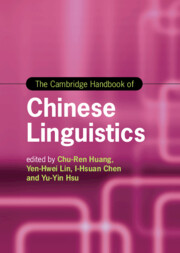Book contents
- The Cambridge Handbook of Chinese Linguistics
- Cambridge Handbooks In Language and Linguistics
- The Cambridge Handbook of Chinese Linguistics
- Copyright page
- Contents
- Figures
- Tables
- Contributors
- Acknowledgments
- Part One Writing System/Neuro-cognitive Processing of Chinese
- Part Two Morpho-lexical Issues in Chinese
- 3 Wordhood and Disyllabicity in Chinese
- 4 Characters as Basic Lexical Units and Monosyllabicity in Chinese
- 5 Parts of Speech in Chinese and How to Identify Them
- 6 Gaps in Parts of Speech in Chinese and Why?
- 7 Derivational and Inflectional Affixes in Chinese and Their Morphosyntactic Properties
- 8 The Extreme Poverty of Affixation in Chinese
- 9 On an Integral Theory of Word Formation in Chinese and Beyond
- 10 Compounding Is Semantics-driven in Chinese
- Part Three Phonetic-phonological Issues in Chinese
- Part Four Syntax-semantics, Pragmatics, and Discourse Issues
- Index
- References
9 - On an Integral Theory of Word Formation in Chinese and Beyond
from Part Two - Morpho-lexical Issues in Chinese
Published online by Cambridge University Press: 04 August 2022
- The Cambridge Handbook of Chinese Linguistics
- Cambridge Handbooks In Language and Linguistics
- The Cambridge Handbook of Chinese Linguistics
- Copyright page
- Contents
- Figures
- Tables
- Contributors
- Acknowledgments
- Part One Writing System/Neuro-cognitive Processing of Chinese
- Part Two Morpho-lexical Issues in Chinese
- 3 Wordhood and Disyllabicity in Chinese
- 4 Characters as Basic Lexical Units and Monosyllabicity in Chinese
- 5 Parts of Speech in Chinese and How to Identify Them
- 6 Gaps in Parts of Speech in Chinese and Why?
- 7 Derivational and Inflectional Affixes in Chinese and Their Morphosyntactic Properties
- 8 The Extreme Poverty of Affixation in Chinese
- 9 On an Integral Theory of Word Formation in Chinese and Beyond
- 10 Compounding Is Semantics-driven in Chinese
- Part Three Phonetic-phonological Issues in Chinese
- Part Four Syntax-semantics, Pragmatics, and Discourse Issues
- Index
- References
Summary
After critically reviewing the conflicting theories of word-formation, the integral model in Li 2005 is presented which is shown not only to make a minimal number of postulations but also to cover a wide range of cross-linguistic facts: morphological causativization in Bantu and Semitic, compounding in Chinese and English, the resultative constructions in Chinese, and noun-incorporation in Amerindian. Underlying this chapter is the long-lasting debate in this part of linguistic theorization as well as the methodological implications of the integral solution.
Keywords
Information
- Type
- Chapter
- Information
- The Cambridge Handbook of Chinese Linguistics , pp. 174 - 197Publisher: Cambridge University PressPrint publication year: 2022
